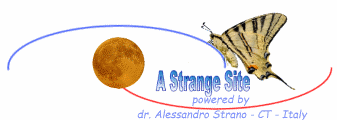IDENTIFICATION OF ARTHROPODA
Introduction
Arthropods are the most numerous "phylum" of the animal kingdom: about the 95% of all known species belong to this "phylum". Arthropods can be distinguished from other animals because they are invertebrate and have articulate legs; this character gives the name to the phylum. They have two compound eyes (formed by many eyes called ommatidia) and/or the ocelli (simple eyes). Most of them are oviparous, they lay eggs, but there are also viviparous arthropods procreating living animals and ovoviviparous arthropods, the incubation of eggs is internal and therefore the eggs open just when they are laid. Generally arthropods are subject to the metamorphosis process. The other terrestrial invertebrate animals belong to the phyla Anellida [usually called as worms (1)] and Mollusca (class of Gastropoda).
Here it is the list of the most common classes of Italian arthropods with terrestrial species. The name of classes is the Latin one and, when available, there is also the link to the photos (in the legend there are the scientific name of order and suborder; family; genus, species and subspecies, and the common name). Photos were taken in Catania and Pedara (Sicily).
See also the guide with pictures and the index cards.
Crustacea Class
Crustacean dermoskeleton (external body layer made of chitin) is strong and generally covered by calcareous (carapace): most of them live in the sea, but some live in rivers, lakes, ponds and there are also terrestrial species. Their body is divided in cephalothorax (thorax and head are fused together) and abdomen; they have two pairs of antennae and are oviparous, generally respiration is brachial. Some orders of this class are: Cladocera (abdomen not segmented, flat body), Isopoda (without carapace, legs are similar, in this order there are many terrestrial species in particular those of family Porcellionidae which can't roll into ball and those of Armadillidiidae which can roll into ball), Decapoda (with carapace, the first three pairs of legs are fitted to catch and triturate food) these last two orders belong to Malacostraca, the subclass with the most developed crustaceans.
See also Crustacea photos
Insecta Class
It is the most numerous class. Insects can be distinguished from other arthropods because adults have 3 pairs of legs. It is this class the only with winged animals.
Go to the insect identification guide
Arachnida Class
Generally, Arachnid body is divided in two sections: cephalothorax (thorax and head are fused together) and abdomen (in species of Opiliones and Acari these sections are fused together), they have neither wings nor antennae. They have four pairs of legs and two pairs of appendages, chelicerae and pedipalps, usually suited to catch and kill preys, in fact many species are carnivorous. Generally respiration is pulmonary; Arachnids have only simple eyes and are oviparous or viviparous.
Go to the arachnid identification guide
Diplopoda Class
Millipede body, just like Centipede one, is divided in two sections: head and trunk, in fact thorax is fused with abdomen. Trunk is divided in many segments with two pairs of legs (a few segments, generally the first and the last ones, may be wingless or with only 1 pair of legs). Antennae are shorter than Centipede ones. They have night habits, respiration is cutaneous or tracheal, in this case a system of small tubes communicating with outside assures the oxygenation of internal tissues. They are oviparous. Chilopoda and Diplopoda are sometimes jointed together into a larger class called Myriapoda. Some of the commonest orders are: Glomerida (cylindrical, short body, 11-12 segments, the family Glomeridae is in this order), Julida (cylindrical, long body, 40 or more segments, the family Julidae is in this order), Polidesmida (flat body, generally with 20 segments, the family Polidesmidae is in this order).
See also Diplopoda photos
Chilopoda Class
Centipede body is divided in two sections: head and trunk, in fact thorax is fused with abdomen. Trunk is divided in many segments with one pair of legs. Antennae are long. Respiration is cutaneous or tracheal, they are oviparous and have night habits. Some of the commonest orders are: Geophilomorpha (31-177 pairs of legs, the family Geophilidae is in this order), Lithobiomorpha (15 pairs of legs, the family Lithobiidae is in this order), Scolopendromorpha (21-23 pairs of legs, the family Scolopendridae is in this order), Scutigeromorpha (15 pairs of long legs, the family Scuterigidae is in this order).
See also Chilopoda photos
Pauropoda Class
Small arthropods, whitish, with 9 pairs of legs and branched antennae.
Symphyla Class
Small arthropods, whitish, with 7-12 pairs of legs and two abdominal appendages.
_____
(1) There are other species called as worms such as those in the phyla Platyhelminthes and Nematoda.



